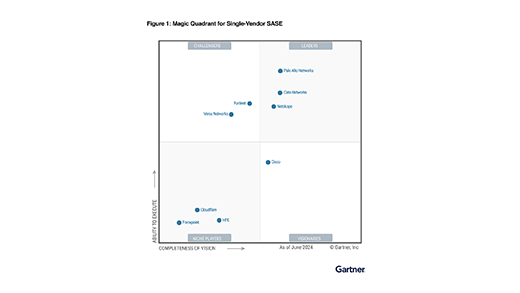2023 fue el año de la IA generativa. Todo comenzó con el bombo en torno a OpenAI y su producto estrella, ChatGPT. Aunque no entró en el top 20 de las aplicaciones más populares de 2023, ChatGPT sumó más usuarios que cualquier otra aplicación, y su popularidad aumentó del 0% a casi el 7% de todos los usuarios empresariales a finales de año. A medida que ChatGPT crecía en popularidad, otras empresas comenzaron a crear chatbots competidores, e incluso más empresas comenzaron a crear productos de nicho para aprovechar el poder de estos grandes modelos de lenguaje (LLM). La idea de un asistente impulsado por IA para ayudar en tareas como escribir, programar e incluso operaciones de seguridad despegó. Al mismo tiempo, también se lanzaron aplicaciones para generar imágenes, videos y audio.
La comunidad de ciberseguridad empresarial hizo lo que suele hacer cuando una nueva tecnología con tanto bombo y platillo llega al mercado: Determinar rápidamente si estas aplicaciones sirven a un propósito empresarial legítimo y, para el caso en que sí lo hagan, averiguar cómo habilitar su uso de forma segura. Para muchas Organizaciones, esto significaba echar el freno, bloqueando las aplicaciones hasta que pudieran pasar por una revisión de seguridad adecuada. En general, esto significó que estas aplicaciones de IA generativa ganaron popularidad en la empresa más lentamente que en el mercado de consumo.
Pero su popularidad creció. El siguiente gráfico muestra un aumento en la popularidad de las aplicaciones de IA que se asemejan a un sigmoide, pasando de poco más del 2% de todos los usuarios empresariales que accedían al menos a una aplicación de IA por mes hace un año a más del 10% que lo hace en la actualidad. La mayor parte de ese crecimiento se produjo en el primer semestre de 2023 y se enfrió hacia finales de año.

Un gráfico del crecimiento de las tres principales aplicaciones de IA generativa proporciona más información sobre la forma del gráfico de popularidad general anterior. ChatGPT fue la aplicación más popular por un amplio margen, con el asistente de escritura Grammarly en segundo lugar, seguido del chatbot Google Bard en tercer lugar. El siguiente gráfico proporciona un desglose detallado del crecimiento de estas tres aplicaciones. ChatGPT fue el principal impulsor del patrón de crecimiento sigmoidal en la primera mitad del año, pasando de casi el 0% al 7% de la población de usuarios empresariales muy rápidamente. Google Bard tuvo una forma similar a su crecimiento más tarde en el año cuando estuvo disponible para el público en general, pero su adopción palideció en comparación con ChatGPT. Grammarly comenzó el año como la aplicación de IA más popular debido a su base de usuarios preexistente, y aunque no experimentó un crecimiento tan agresivo como ChatGPT, su popularidad continúa con una tendencia al alza. En el próximo año, Netskope Threat Labs predice que Grammarly seguirá aumentando su popularidad y reducirá la distancia que le separa de ChatGPT, pero seguirá estando por detrás del chatbot polivalente.

La mayoría de los usuarios solo interactúan con aplicaciones de IA generativa unas pocas veces al mes. En el transcurso del año pasado, el usuario promedio aumentó de 5 actividades por mes a 14 actividades por mes, donde una actividad es más comúnmente un mensaje publicado en un chatbot. El cuartil superior de usuarios de aplicaciones de IA mostró un aumento más significativo, de 15 a 85 actividades a lo largo del año. Esto indica que una cuarta parte de la población de usuarios de IA son usuarios avanzados que están aumentando cada vez más rápidamente su uso de aplicaciones de IA generativa. Netskope Threat Labs espera que ambas tendencias se mantengan en 2024: el número total de usuarios que acceden a las aplicaciones de IA en la empresa seguirá aumentando sólo modestamente, mientras que la cantidad de actividad de los usuarios avanzados aumentará significativamente a medida que la población de superusuarios encuentre nuevas formas de exprimir el valor adicional de estas tecnologías.

Una mirada más cercana a las diez principales aplicaciones de IA generativa a medida que 2023 llega a su fin revela tres tendencias notables que esperamos que continúen en 2024.

Los chatbots reinan
ChatGPT, el primer chatbot de IA generativa en ganar popularidad, sigue en la cima a finales de año, con un 6,7% de los usuarios empresariales que interactúan con el chatbot al menos una vez al mes. Google Bard, la alternativa a ChatGPT de Google, es el segundo chatbot más popular, pero tiene poco más de una décima parte de la base de usuarios. ChatGPT y Google Bard son de uso general y se pueden usar para respaldar funciones comerciales, como ayudar con tareas de escritura y programación o recuperación de información, o para entretenimiento. Su versatilidad es una de las principales razones de su popularidad. Otros chatbots de interacción con el cliente más especializados, ChatBase y Blip, también se encuentran entre los diez primeros, pero con aún menos usuarios.
Los asistentes de IA se están poniendo al día
Uno de los usos más populares de la tecnología de IA generativa en la empresa hasta ahora es como asistente de escritura. Grammarly, la segunda aplicación de IA generativa más popular, es utilizada por el 3,1% de los usuarios empresariales, y las alternativas QuillBot y Wordtune también se encuentran entre las diez primeras. Tabnine es un asistente de programación que ayuda a los programadores a escribir código de manera más eficiente. Netskope Threat Labs prevé que los asistentes de IA, especialmente los de escritura y programación, seguirán ganando popularidad en 2024. Su integración en conjuntos de herramientas de uso común para escribir y programar, y el hecho de que estén diseñados y ajustados específicamente para esas tareas, impulsarán el crecimiento de su popularidad. El hecho de que no se puedan utilizar con fines de entretenimiento también eliminará probablemente las barreras para su adopción en la empresa, mientras que otras aplicaciones, como los chatbots de propósito general, pueden sufrir.
Los generadores de arte de IA se están trasladando a la empresa
Los generadores de arte de IA, específicamente aquellos que pueden generar imágenes, se abrieron camino en los puestos número 9 y 10 de las aplicaciones de IA generativa más populares en la empresa. Al igual que los chatbots, los generadores de arte de IA son herramientas polivalentes que pueden utilizarse para el entretenimiento o para apoyar las funciones empresariales, lo que influye en su popularidad en la empresa. Debido a sus usos de entretenimiento, especialmente su capacidad para generar contenido que no es seguro para el trabajo, es probable que permanezcan en la parte inferior de la lista de popularidad en entornos empresariales en el futuro previsible.




 Atrás
Atrás 

















